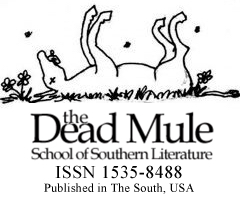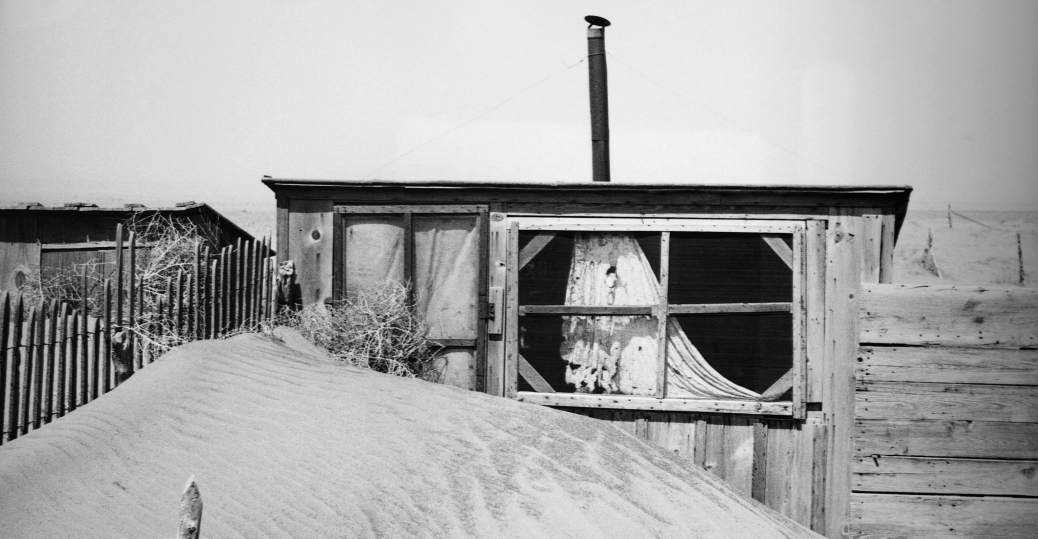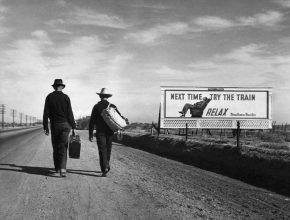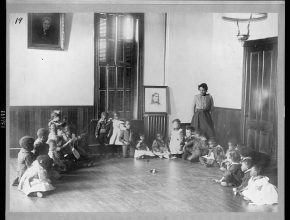Southern Legitimacy Statement: (In Faulknerian style) I was born in LA (Lower Alabama) rural Escambia County, Alabama (near the state line) right above Escambia County, Florida, (who spends its whole life trying to be Escambia County, Alabama), and raised in a rambling old near bout never painted, decomposing house built by my Great Grandfather who moved to Alabama singlemindedly to build a sawmill who went on to destroy the virginal forest by clear cutting the revered long leaf pine not thinking past today, motivated by the almighty dollar with no thought of the Christ-haunted sanctity of the forest –adding insult to injury of destroying the native culture of the Creek Indian, after taking on airs and treating the true owners of the land as savages, not people, who were not capable of owning and destroying land. I lived within walking distance of Burnt Corn Creek, Murder Creek, and their southward rushing jagged junctures with the Conecuh River, where my kin was brutally murdered by a runaway slave and a renegade Indian, where Andrew Jackson camped while chasing Tecumseh, where they had not destroyed all the long leafs; I grew up assuming that folks far northward would, by geography alone, all be lots smarter, due to always seeing the white Southern male shown as a beer-drinking, mean-spirited, pickup driving redneck racist, or a whiskey sipping plantation owning, benevolent kind-hearted racist, a good ole boy, some variation of Forrest Gump, somewhat slow, who makes his way in the world not because he is smart, but because he’s somewhat kind or good-hearted, growing up he, without a Father in the whiney-piney woods of rattle-snaked riddled flat land of creeks of 2 kinds, with no more quail because they never had a Mother.
“Count No Count” and “No Show Jones”: The Very Best of the Southern Gothic Tradition
While “Count No Count” Faulkner and “No Show Jones” may not often be cast and studied together, they should be. In the Southern Gothic world , they line up as “top blood brothers”, alcoholics who were in and out of multiple alcohol related calamities and sanatoriums, and Southern artists who rose to the very top of their fields. William Faulkner (1897-1962) hailed from rural Lafayette County near Oxford, Mississippi, while George Jones (1931-2013) was the product of the infamous “Big Thicket” near Beaumont in rural, coastal Southeast Texas. Both men grew up front and center on the raw edge of what they both lived and wrote/sung about: sad, humorous, depressing and triumphant, human stories. Their success was closely linked to the yin and yang of their tumultuous personal experiences of great successes and abject failures.
The accomplishments of William Faulkner and George Jones are each similarly remarkable and inspiring. Faulkner won the Nobel Prize for Literature in 1949, the Pulitzer Prize for Fiction (1955 & 1962), American Academy of Arts and Letters (1962), & 2 National Book Awards. Faulkner wrote 19 Novels, 125 short stories, and 20 screenplays. George Jones was voted Male Vocalist of the Year (1962,1963), was inducted into the Country Music Hall of Fame (1970), won Grammys in 1980 and 1998, 1980 and in 1981 he was named Country Music artist of the Year. In 1992 his #1 hit “He Stopped Loving Her Today” was named the “All Time Best Country Song”. George Jones made 128 albums and numerous hit singles.
There is a belief, maybe even a requirement, in the Southern Gothic tradition that an artist, writer, or singer has to be “from the South” to really be able to understand the physical and emotional terrain and the subtle nuances of the burden and blessing of family, e.g., “Southern Belles are born not made” and the curse of ancestry, e.g., “Once a Snopes, always a Snopes”, or “What do you Expect…He’s a Bundren”. Elemental experience is necessary in order to generate and percolate the real product. And it helps even more if you’re from the rural “small town” or “country” South, which seems to guarantee exposure to the formative experiences of The Grand Ole Opry, “virgin kill” hunter faces smeared with fresh deer blood, coon hunting, cane pole fishin’, pretend fighting against Union troops, and incorporating the enormous and unhealthy double standards of sex and race issues.
The Dueling Roles of Narcissism and Low Self Esteem
Both trauma and achievement, like low self worth and grandiosity are linked together in the etiology and diagnostic formulations of a benign narcissism that appears endemic to the South, particularly among the lucky folks who surprise themselves with their own success. The basic idea, much to the dismay of most, is that we all have a “good” side and a “dark” or even “evil” side, i.e., Carl Jung was right after all. The shadow self is alive and well in the Mississippi hill country of Yoknapatawpha County and in the “Big Thicket” in Texas.
Narcissism is a term thrown around a lot casually today, and it’s not all bad. We are all narcissistic to some degree, explaining why we put our best rather than our worst picture on Facebook and why we prefer not to advertise our failures. Some narcissism is necessary to survive, and is more than a little evolutionary. “Benign” as opposed to “malignant” narcissism, as in a clinically diagnosable condition, refers to polar extremes of little or no self-esteem ranging all the way up to extreme grandiosity. Both Faulkner and Jones fit the definition of benign narcissists, which explains why they were both extraordinary artists and “splendid” failures (Faulkner characterized his great novel as “his most splendid failure). Both were masters of humility and pride, poor self-image, neglect if not abuse of others’ needs. They were both thin-skinned short men who would take great offense at simple criticisms. They both had fragile egos, characterized by some as the equivalent of having a ‘bucket with a hole in it’, and a falsely constructed sense of superiority engendering the belief that the rules weren’t made for me.
Overt malignant narcissists tend to be aggressive, self-aggrandizing, exploitative, have extreme needs for grandeur and attention, and who may even be dangerous. Covert’ benign narcissists are more prone to misread and overreact with feelings of neglect or belittlement. They are exquisitely sensitive to criticism and are generally hypersensitive and anxious. As benign narcissists- both short in stature, these two “giants” have much in common. Faulkner was rejected in his bid to become a U.S. pilot in WW1, because he was ‘too short’. He then joined the Canadian RAF, where he never saw any active flight duty, but went on to later fabricate air battles and brag about his conquests. His donning the RAF uniform and a can, walking around the square in Oxford, won him the handle of “Count, No Count”.
On the other hand, parts of their personality clearly were striving for perfection. Beneath the true grandeur of their phenomenal successes, Jones and Faulkner were benignly narcissistic, complicated, wonderful, life enhancing, self-destructive geniuses. They both had a very clear picture of the possibility of true human goodness and ultimate success. In the same way, they each clearly appear to have been chronically distrustful and uncomfortable with success. As a result, they would frequently sabotage and undermine their own best efforts. This explains the common frequent variations from grand slam writing and singing to winding up in a sanatorium, which was experienced by both artists. Yet, somehow through heavy exposure to trauma and pessimistic world views, they both ultimately emerge as optimistic humanists who are then so loved because ‘they are so real”. They leave readers and listeners with hope and the certainty that we will endure and prevail in the long run.
Social Anxiety- “Hell is Other People”- Jean Paul Sartre
Both Faulkner and Jones were insecure diminutive men who vacillated between withdrawn, reclusive behavior and very extroverted public displays of their art, clearly bolstered by “liquid courage”. Both men were binge drinkers with strong proclivities toward using drunken sprees to “no show” public events. Their stories/lyrics reveal similar philosophic tensions between free will and determinism, as well as the “sorry” versus the “heroic” nature of men and women. Both loved women in lustful ways and both clearly felt that women provide much of the strength and direction to the “better angels of our nature”. Both artists could tear your heart out when they sing/write the “gothic blues”.
Faulkner identified the positive character traits that he wrote about as “verities of the human heart”: the virtues of courage, honor, loyalty, pride, compassion, and pity ((Gywnn & Blotner, 1959/1995, p. 133). At the same time, he could present the worst of the “Southern white trash” genre with abundant servings of doom, gloom, decay, and despair. This essay focuses on two of their most representative and similar works that exemplify the features noted above: William Faulkner’s A Rose for Miss Emily (1930) and George Jones #1 hit “He Stopped Loving Her Today” (1965).
The above themes discussed are present throughout the works of both artists but perhaps best represented in these similar works. The full lyrics of Jones’ “He Stopped Lovin’ Her Today” and a concise summary of Faulkner’s “A Rose for Miss Emily” are presented below.
April 1980 Greatest Country Song of All Time (written by Bobby Braddock)
He said “I’ll love you till I die”
She told him “you’ll forget in time”
As the years went slowly by
She still preyed upon his mind
He kept her picture on his wall
Went half-crazy now and then
He still loved her through it all
Hoping she’d come back again
meaning
Kept some letters by his bed
Dated nineteen sixty-two
He had underlined in red
Every single “I love you”
I went to see him just today
Oh, but I didn’t see no tears
All dressed up to go away
First time I’d seen him smile in years
He stopped loving her today
They placed a wreath upon his door
And soon they’ll carry him away
He stopped loving her today
You know, she came to see him one last time
Aww, and we all wondered if she would
And it kept runnin’ through my mind
“This time he’s over her for good”
He stopped loving her today
They placed a wreath upon his door
And soon they’ll carry him away
He stopped loving her today
(permission pending)
PLOT SUMMARY OF FAULKNER’S “A ROSE FOR MISS EMILY” (1930)
The story begins at the huge funeral of Miss Emily Grierson. Nobody has been to her house in ten years. Her house is old, but was once part of an aristocratic world. The town revered Miss Emily, even as she became more odd and reclusive. She refused to pay her property tax, claiming a permanent pass granted to her by a town father.
Thirty years before, the townspeople had a strange encounter with Miss Emily about a putrid smell at her place. This was about two years after her father died, and a short time after her lover disappeared from her life. Anyhow, the stink got stronger and complaints were made, but the authorities didn’t want to confront Emily about the problem. So, they sprinkled lime around the house and the smell was eventually gone.
Everybody felt sorry for Emily when her father died. He left her with the house, but no money. When he died, Emily refused to admit it for three whole days. The town didn’t think she was crazy then, but assumed it was a grieving problem.
Soon after her father died, Emily begins dating Homer Barron, who is in town on a sidewalk-building project. The town heavily disapproves of the affair and brings Emily’s cousins to town to stop the relationship. One day, Emily is seen buying arsenic at the drugstore, and the town thinks that Homer is giving her the shaft, and that she plans to kill herself.
When she buys a bunch of men’s items, they think that she and Homer are going to get married. Homer leaves town, then the cousins leave town, and then Homer comes back. He is last seen entering Miss Emily’s house. Emily herself rarely leaves the home after that, except for a period of half a dozen years when she gives painting lessons.
Her hair turns gray, she gains weight, and she eventually dies in a downstairs bedroom that hasn’t seen light in many years. The story cycles back to where it began, at her funeral. Then Miss Emily’s servant lets in the town women into the old house. The townspeople go upstairs to break into the room that they know has been closed for forty years.
Inside, they find the corpse of Homer Barron, rotting in the bed. On the dust of the pillow next to Homer they find an indentation of a head, and there, in the indentation, a long, gray hair.
Faulkner’s “A Rose for Miss Emily”, his most popular short story, inspired Rod Argent of the Zombies to write a hit single, “A Rose for Emily” (lyrics below) that also later became the theme song for the most popular podcast of all time: “S***Town produced by NPR’s Serial and This American Life.
Written by R. Argent, Publisher(s): Marquis Songs USA, Record Label(s): JULY 1968 Marquis Enterprises Ltd
The Zombies Lyrics
“A Rose For Emily”
The summer is here at last
The sky is overcast
And no one brings a rose for Emily
She watches her flowers grow
While lovers come and go
To give each other roses from her tree
But not a rose for Emily…
Emily, can’t you see (how the sun is shining again)
There’s nothing you can do?
There’s loving everywhere
But none for you…
Her roses are fading now
She keeps her pride somehow
That’s all she has protecting her from pain
And as the years go by
She will grow old and die
The roses in her garden fade away
Not one left for her grave
Not a rose for Emily…
Emily, can’t you see (how the sun is shining again)
There’s nothing you can do?
There’s loving everywhere
But none for you…
Her roses are fading now
She keeps her pride somehow
That’s all she has protecting her from pain
And as the years go by
She will grow old and die
The roses in her garden fade away
Not one left for her grave
Not a rose for Emily… (permission pending)
This type of Gothic writing, a genre that was popular in 18th century England, inspired southern Gothic literature. In Gothic literature, the authors wanted to expose the problems they saw in society. The authors wrote fiction, but included supernatural and romantic elements. They were often stories of hauntings, death, darkness and madness.
Southern Gothic does not get mired down or stuck in any one element. Rather, there is a dark humor and great irony in the stories. Southern Gothic follows the idea of exposing the problems of society, but does so through the development of complex characters. The artists explored both the normal and strange behaviors of people as well the social order of the South and the vestiges of slavery and racism. Through their stories, the authors hoped to show that the social order was fragile, and the realities behind it were sometimes disturbing. They are artists who work to point out truths of Southern culture, its strengths, and moral shortcomings. There are remnants of the old South, the old social order, and false pride in hypocritical Antebellum, Old South traditions. Both Faulkner’s and Jones’ work exemplifies the best of these genres.
Close to the raw emotive experience of their communities and environments these are writers who spend their imaginative energy on the “postage stamp” of soil beneath their feet; writers who know, in other words, of what they speak. What makes this crucial to the southern gothic is found in the idea that “we can laugh at ourselves, but you best not”. The southern gothic is, always, from the center of the culture, with realism about the best and the worst of times.
The most important thing to a Southerner is not wealth. In fact, some of the best families in the South have not had money for generations, but they are rich in the tradition of…. “Oh they’re newcomers, they just moved here at the turn of the century….No, Not that century…I mean 1900”. It’s family name, lineage and tradition….even in poor white trash families who would rather have their family bible than a fancy dress. What Southerners put above all else are breeding and manners. When a person puts money above manners, they deserve and receive the worst of all possible insults, e.g., “New Rich”. They are called tacky, and not truly “Southern”.
In April of 2013, following the death of Jones that very day, Holly Gleason of CMT News wrote that Jones’ singing was a voice of “kerosene teardrops about to burst into a raging fire”. When George Jones sang a song, there was never any doubt that he committed completely to whatever emotion — usually one of raw ache, unfiltered regret, unspeakable torment — the song held.
And he could pick ’em. “Window Up Above,” “Good Year for the Roses,” “The Grand Tour,” “Walk Through This World With Me,” “If My Heart Had Windows”. They turned on all incisive moments in the caverns of the human heart. Even his novelty songs were world class, be it the hiccupping “White Lightning,” the horse track metaphoric “The Race Is On” or, in later years, the feisty all-star “I Don’t Need Your Rocking Chair.” (Gleason, 2013). In the same way Faulkner could pick titles and write ’em, e.g., ‘The Sound and the Fury”, “As I Lay Dying”, “Light in August”, “Barn Burning” to name a few.
In the quest for us all of “normality”, we are eternally grateful for these two world class artists for showing us that …… even in the best of us, there also lurks the worst of us. In fact, mark this as a proposal for much wider acceptance of the idea that happiness lies, not in getting rid of our “bad” (or “good”) natures, but in awareness and regulation of their healthy balance. Reading “Count No Count” and listening to “No Show Jones” are clearly part of the recipe as well.







